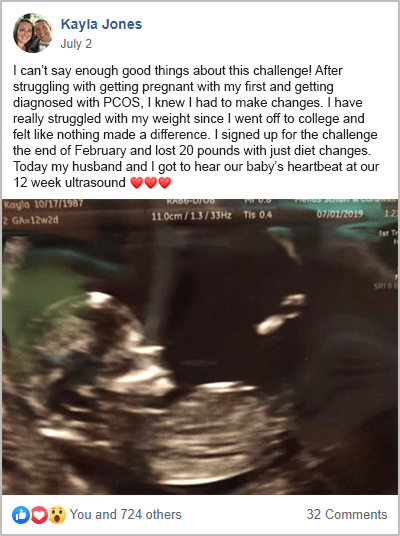There’s debate over the best macros for PCOS. But what everyone in the know agrees on, is that macros are important for managing PCOS.
In this article, you’ll learn everything you need to know about PCOS and macros. I’ve also included an accompanying 3-day meal plan so you can put these ideas into practice.
To better appreciate the benefits of this approach, you can also sign-up for my free 30-Day PCOS Diet Challenge. This unique program includes free weekly meal plans, recipes, shopping lists, and video lessons. The results speak for themselves.
What are Macros?
Macro is short for macronutrients. Four macronutrients make up the entirety of our caloric intake. Fat, carbohydrates, protein, and alcohol. Most foods contain a combination of macros. Meat, for example, is almost exclusively made up of protein and fat. Beans, by comparison, are mostly carbohydrates and protein. The relative amount of each macronutrient in your diet is a valuable metric for improving health.
Macros are expressed as a percentage of total calories. But fractions (a.k.a ratios) work too. The key thing is that they add up to 100% (or 1 in the case of fractions). 100% of your caloric intake comes from the sum of your macros.
Why are Macros Important for PCOS?
The balance of macros in your diet is especially important for women with PCOS. They affect fat loss, muscle preservation, and hormone balance. This makes understanding macros valuable whether you’re trying to lose weight or get pregnant with PCOS.
It’s common for women with PCOS to be told to cut calories to lose weight. In my opinion, this is pretty terrible advice. It’s been known for decades that caloric restriction diets don’t work over the long term. In the majority of cases, people who diet to lose weight end up heavier than before they began [1].
Women with PCOS are also at elevated risk of developing eating disorders [2]. Encouraging ongoing caloric restriction in such a population is a recipe for disaster. I regularly welcome women to my PCOS Facebook Group, who eat so few calories that they’re literally starving themselves.
For these women, in particular, learning to manage macros provides welcome relief. By focusing on macros, rather than calories, women with PCOS can lose weight without going hungry. This is how many of the most successful participants from my free 30-Day PCOS Diet Challenge achieve sustainable weight loss.
Just to be clear, macros are important for women with all types of PCOS, including lean women with PCOS. If you’re struggling to get a regular period, then insulin resistance can be a big part of the problem. Insulin resistance is often missed in normal-weight women with PCOS. Changing your macros can address this problem and lead to better sex hormone regulation.
Recommended Macros for PCOS – Published Values
The USDA recommends the following macros for the average adult [3]:
- Protein: 10 – 35%
- Fat: 20 – 35%
- Carbohydrate: 45 – 65%
A diet with fewer carbohydrates than this is widely understood to be an effective tool in the management of PCOS [4]. But there is a range of macro ratios recommended within this broad category. In part, it depends on your health goals, but also who you ask.
The best macros for PCOS weight loss tend to have lower carbohydrate percentages.
If you do a lot of strength training, then you may prefer higher protein percentages.
The table below shows the range of PCOS macro ratios used in various clinical trials. These are not necessarily the best macros for PCOS. But they provide useful ratios where clinical benefits have been found.
I’ve also included a few values recommended by other online sources.
| Source | Protein | Fat | Carbs |
|---|---|---|---|
|
Moran et al. 2003 [5] |
30% |
30% |
40% |
|
Stamets et al. 2004 [6] |
30% |
30% |
40% |
|
Douglas et al. 2006 [7] |
15% |
45% |
40% |
|
Mehrabani et al. 2012 [8] |
30% |
30% |
40% |
|
Gower et al. 2013 [9] |
19% |
40% |
41% |
|
Wong et al. 2016 [10] |
20% |
35% |
45% |
|
Perelman et al. 2017 [11] |
15% |
45% |
40% |
|
PCOS health coach 1 |
35% |
40% |
25% |
|
PCOS health coach 2 |
30% |
30% |
40% |
|
30% |
40% |
30% |
| Protein | Fat | Carbs |
|---|---|---|
|
30% |
30% |
40% |
|
Moran et al. 2003 [5] |
||
|
30% |
30% |
40% |
|
Stamets et al. 2004 [6] |
||
|
15% |
45% |
40% |
|
Douglas et al. 2006 [7] |
||
|
30% |
30% |
40% |
|
Mehrabani et al. 2012 [8] |
||
|
19% |
40% |
41% |
|
Gower et al. 2013 [9] |
||
|
20% |
35% |
45% |
|
Wong et al. 2016 [10] |
||
|
15% |
45% |
40% |
|
Perelman et al. 2017 [11] |
||
|
35% |
40% |
25% |
|
PCOS health coach 1 |
||
|
30% |
30% |
40% |
|
PCOS health coach 2 |
||
|
30% |
40% |
30% |
My Recommended Macros for PCOS
With this research to guide me, I generally aim for the following ratios when creating macro-balanced recipes for my PCOS meal planner:
- Protein: 20%
- Fat: 60%
- Carbohydrate: 20%
Why 20% Protein
I believe in an adequate protein diet. It doesn’t need to be high protein. The findings of Gower et al. [9], Perelman et al. [11], and Douglas et al. [7] support this level.
From a practical perspective, getting as much as 20% of calories from protein is already a stretch for most women. That’s the equivalent of approximately 16 oz (450 g) of lean meat per day (weighed raw). For vegetarians, you’d need to consume 22 oz (620 g) of tofu to get this much protein.
This is all perfectly achievable, but it can feel like a lot. Keep in mind that to get to 30% protein, you’d need to add another 50% to these amounts.
If you’re working out a lot, you may need a little more. But 20% protein is about right for most people.
Why 20% Carbohydrates
When it comes to carbs, my 20% PCOS macro percentage is tailored for my audience. The majority of women that take part in my free 30-Day PCOS Diet Challenge struggle with insulin resistance. Most of these women want to lose weight. Carbohydrates are key to addressing these issues.
For lean women with PCOS, a 40% allocation to carbs may be more appropriate. Especially if they don’t have insulin resistance or they’re concerned about losing too much weight.
In my experience, a macro ratio of 20% is about as low-carb as you want to go. The only exception to this would be when you know that your post-prandial blood sugar peaks are still too high at this level. Otherwise, 20% is the sweet spot for maximizing insulin sensitivity and PCOS weight loss. Much lower than this, and you’ll risk getting into ketosis. I recommend women don’t follow a keto diet for PCOS.
From a practical perspective, a 20% start-point is also easy to adjust. If you want more carbs, then just up the quantities in my PCOS recipes. It’s also easy to throw in some carb-rich snacks or a PCOS-friendly dessert.
Why 60% Fat
Having a PCOS macro ratio of 60% for fat may seem like a lot. Especially when compared to the PCOS macro ratios published in the scientific literature. Indeed, a meta-analysis of randomized controlled trials showed better results with a low-fat, low-carb diet, than they did for a high-fat, low-carb diet [4].
But the studies analyzed did not control for the type of food being consumed. Only the macro-percentages. This is not evidence that a properly-executed, high-fat PCOS diet is not better than a low-fat equivalent.
The 60% value in my recommendations is a consequence of the protein and carb quantities. Unless you want to eat more protein or carbs, then your only choice is to get a greater percentage of your calories from fat.
The key thing here is that you make this the right kind of fat.
As I’ve written about before, vegetable oils are prominent on my list of foods to avoid with PCOS. Consuming plenty of “healthy fats”, by comparison, is one of the best ways to lose weight with PCOS. This includes fats from meat, fish, avocado, nuts, and seeds.
It’s also worth noting that a diet that’s 60% fat is still significantly less than the 70%+ required for a ketogenic diet. While I don’t recommend it, the proven benefits of the keto diet for PCOS show that an even higher-fat diet can be perfectly healthy when executed well.
Best PCOS Macro Calculator
The easiest way to calculate your macros is to get an app to do it for you. MyMacros+ is one of the highest rated amongst those currently available. MyFitnessPal is the best free app for counting macros.
If you want to understand the math behind these apps, here’s how it works.
Start with your daily caloric intake: Let’s say 2,000 calories.
Multiply this value by your macro ratios to get your caloric intake from each macronutrient.
- Protein = 2,000 calories x 20% = 400 calories
- Fat = 2,000 calories x 60% = 1,200 calories
- Carbohydrates = 2,000 calories x 20% = 400 calories.
You then convert these numbers from calories into grams, by dividing them by the caloric density of each macro:
- 400 calories of protein ÷ 4 calories per gram of protein = 100 grams of protein
- 1,200 calories of fat ÷ 9 calories per gram of fat = 133 grams of fat
- 400 calories of carbs ÷ 4 calories per gram of carbs = 100 grams of carbs
These are your macronutrient daily amounts.
You now need to convert the numbers into quantities of real food.
To do this, you need to know the macro percentages of everything you eat. You can find this information in a range of online databases. Fatsecret.com is a user-friendly example.
For example, 1 cup of cooked black beans gives you 15 g of protein, 1 g of fat, and 41 g of carbs.
To figure this out for everything you eat is a lot of food accounting. That’s why I recommend you use an app. You’ll still need to input everything you eat, but at least you won’t have to do the math.
The Best Way to Manage PCOS Macros
You now understand why macros are important for PCOS. But you also understand that tracking them takes considerable time and commitment.
In my opinion, we can take a more practical approach that gets just as good a result. Here’s what I suggest:
Protein: Consume meat, eggs, and fish at least three times per day. Enjoy big servings.
Carbs: Aim for approximately 4 x 25 gram servings of carbohydrates, spread out across the day. You’ll find this amount of carbs in:
- ½ cup of cooked rice or quinoa.
- ¾ – 1 cup of cooked beans or lentils
- A medium-sized sweet potato
- 2 ½ cups of starchy vegetables such as carrots, beetroot, butternut, or acorn squash.
- 1 cup or 1 medium-sized piece of fruit
Fat: Eat a lot of high-fat food. Add fats and oils liberally to your meals.
You can see some worked examples of recipes that follow these principles in my free 3-Day PCOS Meal Plan.
A Better Alternative to Tracking Macros
The problem with most discussions about macros for PCOS is that they miss the most important point.
Macro-tracking is primarily a means to manage your carb intake. But the whole point of managing carbs is to limit your glycemic response. This is the rate and extent to which your blood glucose levels change with time.
Macro-tracking is an indirect indicator of your glycemic response. It’s measuring the inputs rather than the outputs you’re interested in. It’s also prone to failure at an individual level.
Why go to all this trouble when we can just measure what we’re really interested in instead?
I’m talking about blood glucose monitoring.
Blood glucose monitoring is the best way to improve your insulin sensitivity. Get this right, and weight loss happens on its own. You can eat ‘till you’re full all day, every day. Your blood sugar levels are the only thing you need to pay attention to.
A continuous blood glucose monitor like that offered by Abbott or Dexcom is the ultimate tool for tracking your glycemic response. But a commitment to regular checking with a finger-prick test (flash monitor) can be just as effective over time. This is a much cheaper option too.
These are what optimal glucose ranges should look like:
- Fasting glucose = 72 – 86 mg/dL (4.0 – 4.8 mmol/L)
- Pre-meal (baseline glucose) = 72 – 90 mg/dL (4.0 – 5.0 mmol/L)
- Post-meal glucose peak < 110 mg/dL (6.1 mmol/L) with < 30 mg/dL (1.7 mmol/L) increase from pre-meal levels
- Mean 24-hour glucose = 79 – 100 mg/dL (4.4 – 5.6 mmol/L)
If you can stay within these ranges, your PCOS won’t stand a chance.
The Bottom Line
Tracking macros is much better than counting calories for women with PCOS. Balancing your macronutrients improves hormone regulation without needing to starve yourself. This can be profoundly helpful for managing body composition. But it’s also important for ovulation and fertility.
Determining the best macros for PCOS is an inexact science. But there’s compelling evidence suggesting that women with PCOS should eat fewer carbs than the standard western diet.
The best way to manage PCOS macros is to take a pragmatic approach to food portions. I recommend a high-fat, low-carb, protein-adequate diet. For a sample of macro balanced PCOS recipes, download my free 3-Day Meal Plan. For more meal plans and additional help, join my free 30-Day PCOS Diet Challenge.
To optimize health and fertility, your macros need to control blood glucose levels. Short-term use of blood glucose monitoring devices can help perfect your PCOS-friendly diet.
Author
As a Nutritionist, I’m continuing my mission to help women like you, beat PCOS. Evidence-based diet and lifestyle interventions helped me overcome five years of infertility. I fell pregnant naturally after multiple failed IVF cycles. Along the way, my other PCOS symptoms went away too. This experience taught me how to combine the latest science with a pragmatic approach to habit change. I’ve now helped thousands of other women achieve life-changing results, and I love for you to be the next PCOS success story. Learn more about me and what I do here.
References
1Mann, T., et al., Medicare’s search for effective obesity treatments: diets are not the answer. Am Psychol, 2007. 62(3): p. 220-33.
2Lee, I., et al., Increased risk of disordered eating in polycystic ovary syndrome. Fertil Steril, 2017. 107(3): p. 796-802.
3Manore, M.M., Exercise and the Institute of Medicine recommendations for nutrition. Curr Sports Med Rep, 2005. 4(4): p. 193-8.
4Zhang, X., et al., The Effect of Low Carbohydrate Diet on Polycystic Ovary Syndrome: A Meta-Analysis of Randomized Controlled Trials. Int J Endocrinol, 2019. 2019: p. 4386401.
5Moran, L.J., et al., Dietary composition in restoring reproductive and metabolic physiology in overweight women with polycystic ovary syndrome. J Clin Endocrinol Metab, 2003. 88(2): p. 812-9.
6Stamets, K., et al., A randomized trial of the effects of two types of short-term hypocaloric diets on weight loss in women with polycystic ovary syndrome. Fertil Steril, 2004. 81(3): p. 630-7.
7Douglas, C.C., et al., Role of diet in the treatment of polycystic ovary syndrome. Fertil Steril, 2006. 85(3): p. 679-88.
8Mehrabani, H.H., et al., Beneficial effects of a high-protein, low-glycemic-load hypocaloric diet in overweight and obese women with polycystic ovary syndrome: a randomized controlled intervention study. J Am Coll Nutr, 2012. 31(2): p. 117-25.
9Gower, B.A., et al., Favourable metabolic effects of a eucaloric lower-carbohydrate diet in women with PCOS. Clin Endocrinol (Oxf), 2013. 79(4): p. 550-7.
10Wong, J.M., et al., A randomized pilot study of dietary treatments for polycystic ovary syndrome in adolescents. Pediatr Obes, 2016. 11(3): p. 210-20.
11Perelman, D., et al., Substituting poly- and mono-unsaturated fat for dietary carbohydrate reduces hyperinsulinemia in women with polycystic ovary syndrome. Gynecol Endocrinol, 2017. 33(4): p. 324-327.
As a Nutritionist, I’m continuing my mission to help women like you, beat PCOS. Evidence-based diet and lifestyle interventions helped me overcome five years of infertility. I fell pregnant naturally after multiple failed IVF cycles. Along the way, my other PCOS symptoms went away too. This experience taught me how to combine the latest science with a pragmatic approach to habit change. I’ve now helped thousands of other women achieve life-changing results, and I love for you to be the next PCOS success story. Learn more about me and what I do here.








